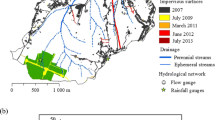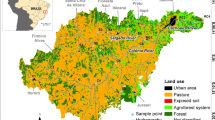Abstract
Purpose
Although the influences of urban land use on water quality have been widely investigated, the impacts of different urbanization patterns, particularly in Mediterranean environments, are not well understood. Focussing on a Portuguese peri-urban catchment with 40 % urban cover, this paper explores (1) the impact of areas with differing urban extent and storm drainage system on streamwater quality and (2) temporal variations driven by season and storm events of differing magnitude, intensity and antecedent weather.
Materials and methods
Water quality was assessed at the catchment outlet (E) and for three upstream tributaries: (1) Porto Bordalo (PB), 39 % urban with a new major road and piping of some overland flow from impervious surfaces directly into the stream; (2) Espírito Santo (ES), 49 % urban, mostly comprising detached houses surrounded by gardens, and with overland flow infiltrating into downslope pervious soils; and (3) Quinta (Q), 22 % urban with partial piping of overland flow from a recent enterprise park area. Water samples were collected at different stages in storm hydrograph responses to ten rainfall events from October 2011 to March 2013. The water quality variables analysed included chemical oxygen demand (COD), nutrients (Kjeldahl nitrogen [Nk-N], ammonium [NH4–N], nitrate [NO3–N] and total dissolved phosphorus (TDP) and heavy metals (Zn and Cu).
Results and discussion
Urban areas had great impact on COD, with the highest median concentrations in ES and the lowest in Q. In ES, fertilizing lawns and gardens may have been responsible for its higher median NO3–N concentrations. High concentrations of heavy metals were recorded in PB and Q, probably due to the piping of road runoff directly into the stream. Generally, higher pollutant concentrations were recorded in the first storm events after the summer drought due to the flushing of accumulated solutes and a lower dilution effect, with Nk-N and NH4–N exceeding water quality standards. Over the wet season, increasing soil moisture favoured greater flow connectivity between runoff processes from pollutant sources and the stream network, leading to a higher proportion of samples exceeding pollution thresholds.
Conclusions
No direct relationship was identified between urban extent and water quality, possibly due to the overriding impact of different storm drainage systems and flow connectivities of different urban patterns. Hydrological regime, linked to seasonal changes, also exerted a major influence on the water quality dynamics. Information on the spatiotemporal dynamics of pollutants, linked to different urban patterns and storm drainage systems, should help enable urban planners to minimize the adverse impacts of urbanization on aquatic ecosystems.





Similar content being viewed by others
References
Alphan H (2003) Land-use change and urbanization of Adana, Turkey. Land Degrad Dev 14:575–586
APHA (1998) Standard methods for examination of water and wastewater, 20th edn. Washington
Barco J, Hogue TS, Curto V, Rademacher L (2008) Linking hydrology and stream geochemistry in urban fringe watersheds. J Hydrol 360:31–47
Binns JA, Maconachie RA, Tanko AI (2003) Water, land and health in urban and peri-urban food production: the case of Kano, Nigeria. Land Degrad Dev 14:431–444
Bowes MJ, Smith JT, Neal C (2009) The value of high-resolution nutrient monitoring: a case study of the River Frome, Dorset, UK. J Hydrol 378:82–96
Çakir G, Un C, Baskent EZ, Kose S, Sirikaya F, Keles S (2008) Evaluating urbanization, fragmentation and land use/land cover change pattern in Istanbul city, Turkey from 1971 to 2002. Land Degrad Dev 19:663–675
Carey RO, Hochmuth GJ, Martinez CJ, Boyer TH, Dukes MD, Toor GS, Cisar JL (2013) Evaluating nutrient impacts in urban watersheds: challenges and research opportunities. Environ Pollut 173:138–149
Crabtree B, Moy F, Whitehead M, Roe A (2006) Monitoring pollutants in highway runoff. Water Environ J 20:287–294
Dias-Ferreira C, Pato RL, Silva H, Varejão JB, Tavares A, Ferreira AJD (2016) Heavy metal and PCB spatial distribution pattern in sediments within an urban catchment—contribution of historical pollution sources. J Soils Sediments (this issue)
Ferreira CSS, Walsh RPD, Steenhuis TS, Shakesby RA, Nunes JPN, Coelho COA, Ferreira AJD (2015) Spatiotemporal variability of hydrologic soil properties and the implications for overland flow and land management in a peri-urban Mediterranean catchment. J Hydrol 525:249–263
Ferreira CSS, Walsh RPD, Shakesby RA, Keizer JJ, Soares D, González-Pelayo O, Coelho COA, Ferreira AJD (2016a) Differences in overland flow, hydrophobicity and soil moisture dynamics between Mediterranean woodland types in a peri-urban catchment in Portugal. J Hydrol 533:473–485
Ferreira CSS, Walsh RPD, Nunes JPC, Steenhuis TS, Nunes M, de Lima JLMP, Coelho COA, Ferreira AJD (2016b) Impact of urban development on streamflow regime of a Portuguese peri-urban Mediterranean catchment. J Soils Sediments. doi:10.1007/s11368-016-1386-5
Ferreira AJD, Soares D, Serrano LMV, Walsh RPD, Dias-Ferreira CM, Ferreira CSS (2016c) Roads as sources of heavy metals in urban areas. The Covões catchment experiment, Coimbra, Portugal. J Soils Sediments (under review)
Fletcher TD, Andrieu H, Hamel P (2013) Understanding, management and modelling of urban hydrology and its consequences for receiving waters: a state of the art. Adv Water Resour 51:261–279
Gallo EL, Brooks PD, Lohse KA, McLain JET (2013) Land cover controls on summer discharge and runoff solution chemistry of semi-arid urban catchments. J Hydrol 485:37–53
Gilbert JK, Clausen JC (2006) Stormwater runoff quality and quantity from asphalt, paver, and crushed stone driveways in Connecticut. Water Res 40:826–832
Hammer TR (1972) Stream channel enlargement due to urbanization. Water Resour Res 8(6):1530–1540
Herrera Environmental Consultants (2007) Untreated highway runoff in Western Washington. Technical Report prepared for Washington State Department of Transportation. http://www.wsdot.wa.gov/NR/rdonlyres/B947A199-6784-4BDF-99A7-DD2A113DAB74/0/BA_UntreatedHwyRunoffWestWA.pdf
Keesstra SD, Bruijnzeel LA, van Huissteden J (2009) Meso-scale catchment sediment budgets: combining field surveys and modeling in the Dragonja catchment, southwest Slovenia. Earth Surf Process Landf 34:1547–1561
Kuusisto-Hjort P, Hjort J (2013) Land use impacts on trace metal concentrations of suburban stream sediments in the Helsinki region, Finland. Sci Total Environ 456–457:222–230
Lana-Renault N, Latron J, Karssenberg D, Serrano-Muela P, Regués D, Bierkens MFP (2011) Differences in streamflow in relation to changes in land cover: a comparative study in two sub-Mediterranean mountain catchments. J Hydrol 411:366–378
Le Pape P, Ayrault S, Michelot JL, Monvoisin G, Noret A, Quantin C (2013) Building an isotopic hydrogeochemical indicator of anthropogenic pressure on urban rivers. Chem Geol 344:63–72
Lin T, Gibson V, Cui S, Yu C-P, Chen S, Ye Z, Zhu Y-G (2014) Managing urban nutrient biogeochemistry for sustainable urbanization. Environ Pollut 192:244–250
Mallin MA, Wheeler TL (2000) Nutrient and faecal coliform discharge from coastal North Carolina golf courses. J Environ Qual 29:979–986
Miller WR (2002) Influence of rock composition on the geochemistry of stream and spring waters from Mountainous Watersheds in the Gunnison, Uncompahgre, and Grand Mesa National Forests, Colorado. U.S. Geological Survey Professional Paper 1667, V. 1.0, Colorado. http://geology.cr.usgs.gov/pub/ppaper/p1667/
Miller JD, Kim H, Kjeldsen TR, Packman J, Grebby S, Dearden R (2014) Assessing the impact of urbanization on storm runoff in a peri-urban catchment using historical change in impervious cover. J Hydrol 515:59–70
Nathan RJ, McMahon TA (1990) Evaluation of automated techniques for base flow and recession analyses. Water Resour Res 26(7):1465–1473
Pato TL, Castro P, Tavares AO (2016) The relevance of physical forces on land-use change and planning process. J Environ Plan Manag 59:607–627
Pereira P, Giménez-Morera A, Novara A, Keesstra S, Jordán A, Masto RE, Brevik E, Azorin-Molina C, Cerdà A (2015) The impact of road and railway embankments on runoff and soil erosion in eastern Spain. Hydrol Earth Syst Sci Discuss 12:12947–12985
Rautengarten A (2006) Sources of heavy metal pollution in the Rhine Basin. Land Degrad Dev 4(4):339–349
Rodríguez-Blanco ML, Taboada-Castro MM, Taboada-Castro MT (2013) Phosphorus transport into a stream draining from a mixed land use catchment in Galicia (NW Spain): significance of runoff events. J Hydrol 481:12–21
Shuster WD, Bonta J, Thurston H, Warnemuende E, Smith DR (2005) Impacts of impervious surface on watershed hydrology: a review. Urban Water J 2(4):263–275
Skalar (2004a) Skalar methods, analysis: nitrate + nitrite, cat nr. 461-322(+P1), p 11
Skalar (2004b) Skalar methods, analysis: ammonia, cat nr. 155-316Xw/r. p 7
Sliva L, Williams DD (2001) Buffer zone versus whole catchment approaches to studying land use impact on river water quality. Water Res 35(14):3462–3472
Tu J (2011) Spatially varying relationships between land use and water quality across na urbanization gradient explored by geographically weighted regression. Appl Geogr 31:376–392
US EPA (1986) Quality criteria for water. EPA-440/586-001, Office of Water Regulation and Standards, Washington
Vidon P, Hubbard LE, Soyeux E (2009) Seasonal solute dynamics across land uses during storms in glaciated landscape of the US Midwest. J Hydrol 376:34–47
Wilbers GJ, Becker M, Nga LT, Sebesvari Z, Renaud FG (2014) Spatial and temporal variability of surface water pollution in the Mekong Delta, Vietnam. Sci Total Environ 485–486:653–665
World Reference Base (WRB) for Soil Resources (2006) A framework for international classification, correlation and communication, FAO, p 145
Yang J-L, Zhang G-L, Shi X-Z, Wang H-J, Cao Z-H, Ritsema CJ (2009) Dynamic changes of nitrogen and phosphorus losses in ephemeral runoff processes by typical storm events in Sichuan Basin, Southwest China. Soil Tillage Res 105:292–299
Yang G, Bowling LC, Cherkauer KA, Pijanowski BC (2011) The impact of urban development on hydrologic regime from catchment to basin scales. Landsc Urban Plan 103:237–247
Yao L, Chen L, Wei W, Sun R (2015) Potential reduction in urban runoff by green spaces in Beijing: a scenario analysis. Urban For Urban Green 14:300–308
Yu S, Wu Q, Li Q, Gao J, Lin Q, Ma J, Xu Q, Wu S (2014) Anthropogenic land uses elevate metal levels in stream water in na urbanizing watershed. Sci Total Environ 488–489:61–69
Yu S, Xu Z, Wu W, Zuo D (2016) Effect of land use types on stream water quality under seasonal variation and topographic characteristics in the Wei River Basin, China. Ecol Indic 60:202–212
Zdruli P (2014) Land resources of the Mediterranean: status, pressures, trends and impacts on future regional development. Land Degrad Dev 25:373–384
Zhang Y, Shuster W (2014) Impacts of spatial distribution of impervious areas on runoff response of hillslope catchments: simulation study. J Hydrol Eng 19(6):1089–1100
Zhao J, Lin L, Yang R, Liu Q, Qian G (2015) Influences of land use on water quality in a reticular river network area: a case study in Shanghai, China. Landsc Urban Plan 137:20–29
Acknowledgements
This research was carried out as part of (1) research fellowship SFRH/BD/64493/2009, funded by FCT, under QREN–POPH and co-funded by ESF and MEC national funds, and (2) research project PTDC/AUR-URB/123089/2010, funded by FCT, COMPETE and European Regional Development Fund. The authors would like to acknowledge Daniel Soares and Célia Bento for water sampling assistance and Alécia Branco, María Fernandez and Romina Baston for their support on laboratorial work.
Author information
Authors and Affiliations
Corresponding author
Additional information
Responsible editor: Artemio Cerdà
Rights and permissions
About this article
Cite this article
Ferreira, C.S.S., Walsh, R.P.D., de Lourdes Costa, M. et al. Dynamics of surface water quality driven by distinct urbanization patterns and storms in a Portuguese peri-urban catchment. J Soils Sediments 16, 2606–2621 (2016). https://doi.org/10.1007/s11368-016-1423-4
Received:
Accepted:
Published:
Issue Date:
DOI: https://doi.org/10.1007/s11368-016-1423-4




